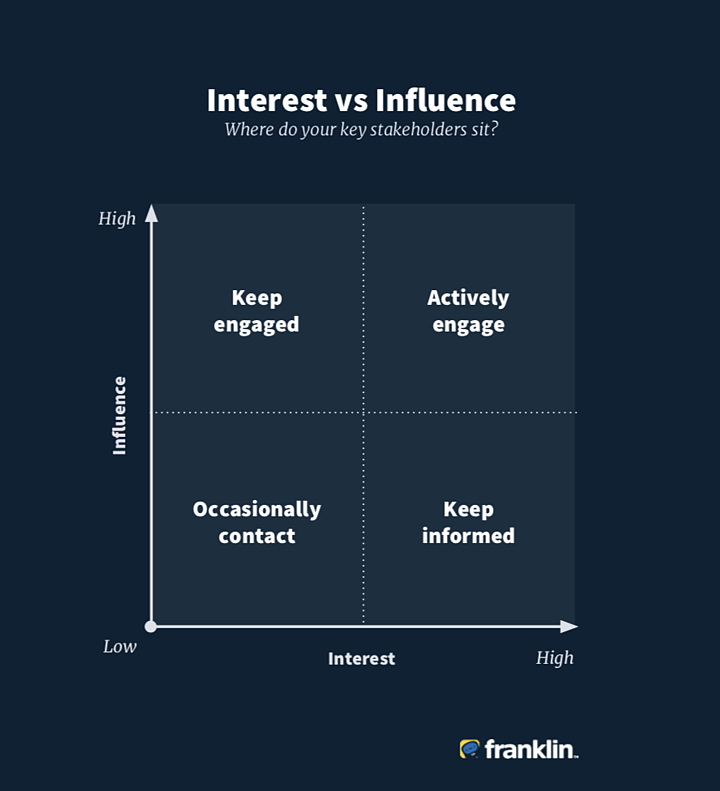Channel shift projects are at least as much about mindset change as technological change so, if you want your self-service portal project to get off to a smooth start, getting stakeholder buy-in from the beginning is a must.
- Prepare the business case
- Define your stakeholders
- Stakeholder mapping
- Key messages
- Identify your communication tactics
- Sharing the news
Approach gaining buy-in for a portal as you would any other initiative involving change management – exactly the same principles apply. Your communications strategy for the project is going to be critical as your stakeholders work their way along the change curve, so it’s smart to enlist the support of your in-house comms team early on. Do so, and the process of gaining buy-in will become much more straightforward.
Prepare the business case
Be clear about what you’re trying to achieve: it’s very hard to ‘sell’ anything, if you haven’t put together a clear business case. Set out your hard and soft goals, and make it clear what the benefits will be – not just to your organisation and its employees, but to your tenants.
Define your stakeholders
Think about who you need to get on side, from internal groups to external stakeholders. Your list of key stakeholders may look something like this:
External stakeholders
- Tenants (you may wish to split these into subgroups)
- Community groups
- Civic leaders
- Representatives from other private/public sector organisations
Internal stakeholders
- The Board
- Managers
- Support services
- Frontline staff
Stakeholder mapping
Now that you’ve listed out your stakeholders, you can carry out a stakeholder mapping exercise to determine which groups’ support will be most critical to your portal project. This is something your comms team should have plenty of experience in, but if you need to work out how your stakeholders could impact the portal project yourself, you can take the following approach:
Step 1. Use a simple interest versus influence matrix to help you to decide on your strategy for getting buy-in from key groups. Work out where each group sits on the matrix – you can see how the comms approach will vary based on the level of interest/influence.

Step 2. Once you’ve completed this step, you can work out your tactics for getting the support – or at least avoiding the resistance – of those least likely to favour the introduction of your portal. Use the following guidelines to steer your tactics.
Low interest, low influence: stakeholders who might be fairly unimportant to your project – still keep them in the loop, in case they decide to ‘mobilise.’
High interest, low influence: be wary of ignoring this group: even though they probably can’t derail the project, they could attempt low-level blocking and other types of resistance.
Low interest, high influence: only become problematic if persuaded to act for high interest low, influence groups. Retain their support through regular meetings and communications.
High interest, high influence: powerful advocates or opponents – so any high/high stakeholder groups need to be kept fully informed and given a sense of ownership.
Key messages
Now that you’ve identified your stakeholder groups and assessed how they can impact the portal’s progress, sense check your business case. Do you think you’ve answered all potential objections? Pull out the key messages that will allay concerns – you may wish to compile a predictive list of FAQs to crystallise how you will answer questions.
These are the sort of questions you should be ready to field:
External stakeholders
- Will the portal be complicated to use?
- What is it for?
- Why do we need it?
- How will I register to use it?
- What if I want or need to speak to someone?
- I don’t use the internet, how will I pay my rent?
- When will the portal happen?
Internal stakeholders
- What will happen to the people who normally deal with these transactions?
- Will I need to know anything about the portal myself?
- Will my job change?
- How will I be able to see the information in the portal?
- What happens to the tenants who don’t sign up to use the portal?
- Is the system complicated to navigate and understand from our side?
- How much is this going to cost?
- Why do we need it?
Identify your communication tactics
Now that you have a good idea of what you want to say, and to whom, you need to identify the most appropriate communication channels for each key stakeholder group. For external stakeholders – in essence, the main group of concern here will be tenants – this could include newsletters, community noticeboards, e-news or even a mini-roadshow.
Internal stakeholders are perhaps more complex to address, as there will be a variety of degrees of interest and influence. Here, take advice from your in-house internal comms expert, who will be able to fill you in on everything from when the deadline is for the next staff newsletter to helping plan cascade meetings. It may be a relatively straightforward matter to communicate your vision to the Board, but it’s important to have communications lined up and synchronised across all internal stakeholder groups to avoid misinformation spreading via the grapevine, once the project’s got the go-ahead.
Sharing the news
Many of your tenants will see a user-friendly portal as a welcome initiative that will make life easier for them, so second-guessing a negative reaction, while a sensible precaution, could prove to be less necessary than you may have expected. What’s important is to create opportunities for tenants to ask questions and feedback, to be transparent about the timeline for delivery and to be ready to reassure those who may struggle to access the portal.
Internally, there will be plenty of questions – but if your new portal will simply be an improvement on an existing one, it’s unlikely to arouse a negative response and employees will most likely take it in their stride with minimal fuss.
However, if you’re embarking on a major foray into digital transformation as portal first-timers, individual responses may well contain an element of fear of the future. Remember that while creating buy-in from the top down is essential, it’s vital to create digital champions at all levels of the organisation to help communicate the positives – this consistency of communication will be invaluable in helping the organisation as a whole to adjust. Make sure that there are plenty of opportunities for employees’ views and questions to be heard and responded to as you move on with the portal project.
Once you’ve crossed the first hurdle of gaining initial buy-in, keep on communicating progress at an appropriate level for each stakeholder group. Not only will this avoid any sudden surprises when the portal finally launches, but you should find it easier to both generate enthusiasm for training and role changes amongst employees, and recruit beta testers from your tenants, if all stakeholders are well primed.



.jpg)
